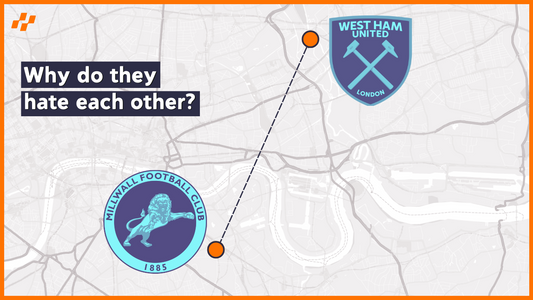
Why Leeds United Were Almost Expelled From The Football League
Share
Doing a Leeds, its a term widely used in english football to describe finacinacal missmanagement with in a football club. and if you ask any Leeds United fans, they’ll know why their club had become associated with the term, as they watched their club spend its way to the top, only to come crashing down in spectacular fashion.
In just six years, they went from Champions League semi-finalists to League One strugglers, all due to reckless spending and poor financial planning.
In our next episode of How Not To Run A Football Club, we take a look into Leeds United and by the end, you'll understand why 'Doing a Leeds' became known for financial mismanagement in football.
Click here to watch the full video on our YouTube channel
The Rise of Leeds United in the Late 1990s
Today’s football fans may not realise just how big Leeds United once was. But those who watched in the '90s remember a club that was truly feared. Their success began in the mid-90s, winning the English title in 1992 and regularly finishing near the top of the Premier League into the early 2000s.
From 1998 to 2002, Leeds secured five consecutive top-five finishes, competing in Europe and reaching the Champions League semi-finals in 2000-01. Beneath this success, however, financial risks were piling up.
This golden era was built on a talented squad and bold management. David O’Leary, who became manager in 1998, brought an exciting, high-energy style, leading to memorable moments like Mark Viduka’s four-goal performance in a 4-3 win over Liverpool.
Alongside big-money signings like Rio Ferdinand, who the club broke the British transfer record to sign him from West Ham in November 2000 for £18m, homegrown players from Leeds’ youth academy, including fan favourite Alan Smith, all played crucial roles.
However, these achievements came with an increasingly risky financial strategy. Chairman Peter Ridsdale and O’Leary pushed the club to borrow heavily against future revenues, and Leeds’ debt began to soar.
The 2000-01 season marked the peak of Leeds’ success, but this Champions League run was also the high-water mark before their financial decisions started catching up with them.
As we look back at Leeds’ rise, it’s clear that these financial choices laid the groundwork for one of the most dramatic falls in English football history. Within a few years, this Champions League contender would be fighting for survival.
Financial Mismanagement and Mounting Debt
While Leeds United celebrated their Champions League semi-final appearance, few could have imagined the financial crisis that awaited them.
Peter Ridsdale, who at the time was the highest paid executive on about £600k per year, implemented a risky financial strategy that involved borrowing heavily against future gate receipts and TV revenue. This approach was particularly precarious as it hinged on one crucial factor - consistent Champions League qualification.
Leeds United's financial planners were essentially betting on continued success at the highest level of European football to generate the revenue needed to repay their mounting debts.
In the 2000-01 season, the club took out a £60million loan against future gate receipts to fund player purchases. This decision created a financial situation that depended entirely on ongoing success in European competitions.
The club's spending on player wages and transfer fees during this period ranked among the highest in the Premier League, significantly contributing to their escalating debt. Despite the growing financial crisis, Leeds continued their ambitious spending.
They acquired high-profile players like Robbie Fowler for £11million, hoping these investments would secure their place among Europe's elite and generate the necessary income to manage their debts.
Financial experts heavily criticised Leeds' strategy, noting that relying on future income from Champions League participation was a dangerous gamble. Their concerns would prove prophetic when Leeds failed to qualify for the Champions League in 2002, triggering a full-blown financial crisis.
Without the expected revenue from European competition, and spending £90million on players in 3 years, the club found itself unable to meet its financial obligations. So how did they manage? Well... they didn't. So much so that they had to resort to desperate measures just to survive.
The Fire Sale: Selling Stars to Survive
Just imagine watching your favourite football team being torn apart, piece by piece. For Leeds United fans, this nightmare became reality as the club desperately tried to stay afloat.
By June 2002, Leeds United debt had risen to £78Million and their wage bill hit £50million a year. The financial crisis forced Leeds into a corner, with no choice but to sell their prized assets to manage their spiralling debt.
Between 2002 and 2004, Manger David O’Leary was sacked, costing the club £3million in compensation, and Leeds offloaded many of their star players in a desperate attempt to balance their books.
This fire sale saw the departure of some of the club's most talented and beloved players, leaving fans devastated and the team's on-field performance in jeopardy.
The most significant transfer during this period was that of Rio Ferdinand, who moved to Manchester United for £30 million in 2002. Ferdinand's sale was particularly painful for Leeds supporters, as he was a homegrown talent and a key figure in the team's recent successes.
This transfer not only weakened Leeds' defence but also symbolised the club's fall from grace, as they were forced to sell to a direct rival.
Other notable departures included Robbie Keane to Tottenham Hotspur, Jonathan Woodgate to Newcastle United, and Harry Kewell to Liverpool and Robbie Fowler to Manchester City, who they agreed to pay part of his wages just to be able to sell him on.
These players, were not only sold for under their market value, but left gaping holes in Leeds' squad that proved difficult to fill.
The emotional toll on Leeds United supporters was immense. Fans expressed a deep sense of despair and helplessness as they watched their team being dismantled before their eyes. The sentiment of giving up on the club's future permeated the fanbase.
Despite the cash influx from player sales, Leeds United’s financial situation remained precarious. The substantial debt underscored the depth of the club’s mismanagement.
Although the fire sale bought them some time, it came at a devastating cost to the team's competitiveness and the fans’ morale, leaving Leeds United struggling both financially and on the pitch.
Relegation and Further Financial Woes
In March 2003, Ridsdale resigned as chairman, and after further investigation their financial mismanagement extended beyond players, it was discovered Leeds had 70 cars on lease, was hiring private jets and even rented an aquarium for Ridsdale’s office.
Leeds collected a mere eight points from their first 12 games of the 2003-04 season, leading to the dismissal of manager Peter Reid. Eddie Gray was appointed as temporary manager, but despite a brief resurgence, Leeds soon found themselves in a devastating seven-game losing streak.
After 14 years in the Premier League, Leeds United were relegated to the Championship, marking a dramatic fall from grace for a club that had been competing in the Champions League semi-finals just three years earlier.
The loss of Premier League status brought with it a host of new challenges, including reduced television revenue and decreased matchday income.
Dennis Wise was brought in to steady the ship, but the team's on-field performances remained inconsistent. In 2007, the full extent of Leeds United's financial crisis became apparent when the club entered administration, resulting in a points penalty that pushed the team further down the table.
During this period, the phrase "Doing a Leeds" entered football parlance, becoming synonymous with financial mismanagement leading to rapid decline. It served as a stark reminder of how quickly fortunes can change in football when ambition outpaces financial prudence.
As Leeds United grappled with administration, the club's very existence hung in the balance. The team that had once reached the heights of European football now faced the prospect of playing in the third tier of English football for the first time in its history. The road ahead for Leeds United would be long and arduous, with no guarantee of a return to their former glory.
Rock Bottom: League One and Near Extinction
From Champions League semi-finalists to the third tier of English football in just six years, Leeds United's fall from grace was complete. The 2007-08 season marked a new low as they found themselves in League One, the culmination of years of financial mismanagement and poor on-field performances.
As they prepared for the new season, Leeds were hit with a 15-point penalty for failing to follow insolvency rules during their administration period, placing them at a significant disadvantage before the season even began.
The financial situation at Leeds remained critical. Leeds United's very existence was hanging by a thread, with the Football League seriously considering expelling the club entirely due to their financial irregularities.
It was only through last-minute negotiations and agreements that Leeds were allowed to continue in professional football.
Despite these enormous challenges, Leeds United showed remarkable resilience on the pitch. The team, led by manager Dennis Wise, embarked on a strong run of form at the start of the season.
They quickly wiped out their points deficit and found themselves in contention for promotion, bringing a glimmer of hope to the long-suffering Leeds fans.
However, the fairytale comeback was not to be. Leeds narrowly missed out on promotion from League One in the 2007-08 season, finishing in fifth place and losing in the play-off final.
This near-miss was a significant blow to the club's aspirations for recovery and left many wondering how long it would take for Leeds to return to their former glory.
As Leeds prepared for another season in League One, the road back to the Premier League seemed longer and more treacherous than ever before.
The Long Road Back: Championship Years and Premier League Return
Sixteen years separated Leeds United from the Premier League, a journey marked by financial turmoil, tactical shifts, and emotional highs and lows. Leeds' story of redemption offers insights into what it takes for a fallen giant to reclaim its place at the top.
Leeds United's path through the Championship was fraught with challenges. After a few years battling it out in League One, the club finally secured promotion back to the Championship in 2010 under Simon Grayson.
This victory against Bristol Rovers on the final day of the 2009-10 season marked the beginning of Leeds' long road back to the top flight.
The Championship proved to be a formidable battleground for Leeds. The club struggled to mount serious promotion challenges, with mid-table finishes becoming the norm. Managerial instability plagued the team, hindering progress both on and off the pitch.
A crucial turning point came in 2017 when Andrea Radrizzani acquired ownership of the club. This change provided a more stable foundation for Leeds' future, bringing renewed financial stability and a clear vision for restoration.
The arrival of Marcelo Bielsa in 2018 revolutionised Leeds United. The Argentine manager's high-intensity style of play revitalised the team and captivated fans. Despite a heartbreaking playoff loss in 2019, Leeds dominated the 2019-20 Championship season, finishing first with 93 points and securing their long-awaited return to the Premier League.
The 2020-21 Premier League season proved Leeds United were more than just happy to be back. The team finished ninth with 59 points, marking the best performance by a newly-promoted side since Ipswich Town in 2001. This impressive return showcased Leeds' ability to compete at the highest level once again.
That however, did not last very long and Leeds United's journey has come full circle, with the club once again finding themselves in the Championship following their relegation from the Premier League in 2023.
The Futue?
As Leeds United look to the future, their current status in the Championship presents both challenges and opportunities. Radrizzani sold his 56% stake in September 2023 to the consortium led by 49ers Enterprises, who already held 44%.
As of 2024, Leeds United recently informed the Supporter Advisory Board that, even with the sales of key players they’re still operating close to the Championship’s financial fair play limits.
However, promotion to the Premier League will ease a lot of concerns over the club’s financial position given the financial rewards for being in the top flight.
Leeds United's future prospects will depend on their ability to balance financial prudence with on-field ambition, learning from the hard lessons of their past while striving for future success.





